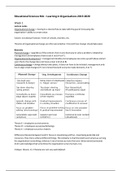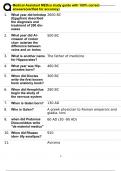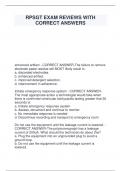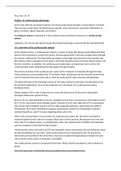Organization
collection of people who work together and coordinate their actions in order to achieve individual and
organizational goals
Basic parts of organizations
1. Strategic apex
- part where direction is set, decisions are made, leadership
and strategic course of organization
2. Middle line
- managers, teamleaders, etc.
- give direct supervision and have leadership role for operating
core
3. Operating core
- where real production takes place and serves are delivered
- relatively big
4. Technostructure
- focus on planning of resources
- making sure that activities of core can be done in efficient and effective manner
5. Support staff
- restaurant, cantine, facilities, finance, resources, etc.
- relatively small
Five periods of organisational theory
1. Classical
2. Human relations
3. Systems
4. Contingency
5. Post-modern
1) Classical view
- goal: to improve organizational structure in order to increase efficiency
- normative
- influencers:
1. Mooney & Reiley
2. Taylor
3. Ford
4. Weber
Mooney & Reiley
Principles:
1. Coordinative principle
- act together, exercising authority, need for discipline
- ie. bringing together work done by different individuals in organizations
- fundamental! → without discipline, organization can’t be successful
2. Scalar principle
- vertical division, hierarchy, delegation
- different departments and business units
3. Functional principle
- horizontal division
- about different functions, not hierarchy
- eg. sales, production and marketing
- difference between line and staff
- line = responsible for achieving primary goals and objectives
, - primary / core process of organization happens in line
- staff = provide support and assistance in specialized areas
- eg. human resources, legal and research and development
- not related to primary processes, not producing directly
- eg. accountant for a restaurant
Taylorism: Scientific Management
Principles:
1. Science
- study work → find out most efficient way to do it
- standardization of processes
- task specialization → assign specific tasks in highly structured manner
2. Harmony
- everybody and everything should be in harmony and lead to same results
- bring everyone’s production efficiency into full play to accomplish maximum profit
3. Coordination
- of everything within organization
4. Development
- not in terms of personal development
- scientifical training for employees for their greatest efficiency and propensity
- propensity = natural tendency to behave in certain way
- let employees not think, just work
- employees are lazy and stupid and should be managed
Fordism
- inspired by Taylor
- mass production
- standardized products
- low costs
- strong division of labor
- work is broken down in different activities designed to different groups of workers
- paternalistic
Taylorism and Fordism
Compared:
- Taylorism is focused on optimizing individual tasks in production of specific product
- Fordism extends this to entire production process → emphasizing mass production, standardization
and vertical integration
Criticism:
- deskilling of workers
- little / no control for workers, very little autonomy → leads to strikes
However:
- contribution to knowledge of what makes organization productive and effective
- higher earnings for companies
- less physical stress → only need to do part of activity, not whole thing
,Example: working conditions
Ford factory Amazon warehouse
- high workload - high workload
- low autonomy - low autonomy
- lack of restroom breaks - lack of restroom breaks
- monitoring by manager - monitoring by technology
- standardized work - standardized work
- relatively good pay - relatively good pay
- unions forbidden - unions strongly discouraged
Bureaucracy (Max Weber)
Characteristics:
1. Specialisation
- of job, not employee
- advantage: efficiency and continuity
2. Hierarchy
- advantage: clarity → everybody knows what is expected from them and where they stand
3. Formal selection
- making sure employee has right qualities and capabilities
- advantage: competent employees
4. Career orientation
- follow certain career path, step up when doing good and adhering to rules
- advantage: better performance because ‘career professionals’ will not deviate from rules
5. System of rules and regulations
- advantage: efficiency will increase as formal rules relating to employee performance are
enforced
6. Impersonality
- advantage: when rules are applied uniformly, there will be no arbitrary actions, no favoritism or
nepotism
Disadvantages:
- bloat
- too many managers, administrators and management layers
- very expensive
- eg. excess management is costing US $3 trillion per year
- friction
- too much busywork (ie. work that is done that doesn’t add value) that slows down decision
making
- insularity
- too much time spent on internal issues
- disempowerment
- too many constraints on autonomy
- risk aversion
- too many barriers to risk taking
- people are not used to making own decision → sets certain ‘culture’
- inertia
- too many impediments to proactive change
- people are not used to making own decision → sets certain ‘culture’
- politics
- too much energy devoted to gaining power and influence
Objections to classical approach
Ignores psychological and social dimension
- limits psychological growth of employee
, - boredom → need for variety
- limited development and use of skills
- limited participation
- limited freedom to determine your own working methods
Inflexibility
- rules must be followed obediently
- ignores external environment of organization
2) Human relations approach
- humanizing work organization
- focus on employee as individual
- analyzing what motivates employees
- eg. Hawthorne experiments
Attention to:
- informal structure
- leadership, motivation and communication
- needs of employees
- groups within organization
Idea: employees aren’t just motivated by money
Classical approach to motivation and control Human relations approach to motivation and control
Assumption Management Assumption Management
Work is inherently Close supervision of People what to feel useful Make each worker feel
distasteful to most behavior (no trust) and important useful and important
people (they are lazy)
What workers do < what Breaking tasks down in People desire to belong Keeping workers informed
they earn for it (homo simple, repetitive, easily and to recognized as and listen to their objections
economicus) learned operations individuals to management plans
Few want / can handle Establishing detailed These needs > money Allow workers to exercise
work which requires work routines and when motivating people self-direction and
creativity, self-direction procedures and enforce self-control in routine
or self-control firmly but fairly matters
Objections to human relations approach
- scientific quality → methodological value of Hawthorne studies
- is satisfied employee really more productive?
- ignores organization and context of organization
- ‘people without organizations’
3) Systems approach
- looks at organization as a whole system
→ relationship between structure and
behavior
- coherence and mutual influence
between parts of organization are
necessary to make organization
successful
- so: input, conversion and output stage
can all be influenced by changes in
external environment







